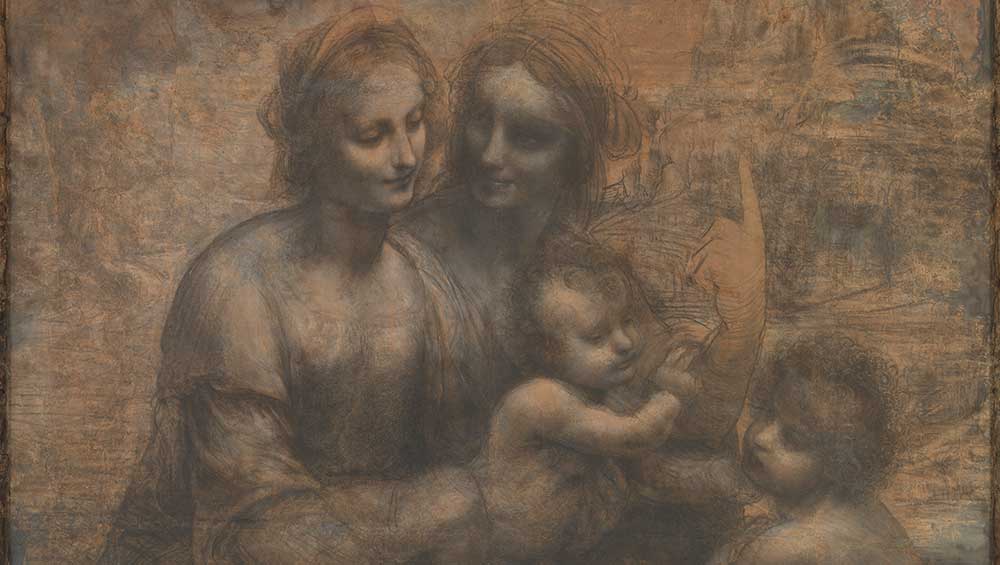
Leonardo da Vinci, The Virgin and Child with St Anne and the Infant St John the Baptist (The Burlington House Cartoon), c1506-08 (detail). Charcoal with white chalk on paper, mounted on canvas, 141.5 x 104.6 cm. The National Gallery, London. Purchased with a special grant and contributions from the Art Fund, The Pilgrim Trust, and through a public appeal organised by the Art Fund, 1962.
Royal Academy of Arts, London
9 November 2024 – 16 February 2025
by ANNA McNAY
This exhibition is the tale of three artists, told in three chapters; a tale of influence, copying and rivalry. The scene is Florence in and around the year 1504; the protagonists are Leonardo da Vinci (1452-1519), Michelangelo (1475-1564) and Raphael (1483-1520). While the majority of drawing exhibitions tend to feature works by a range of artists, with these three among the most highly worshipped, rarely have I seen one hung together to relate such an evolved – and involved – narrative as this.
The story begins on 25 January 1504, when Florence’s leading artists gathered to decide where would be most “convenient and congruent” to place Michelangelo’s standing sculpture, David (1501-04). The shortlist comprised two sites: in front of the Palazzo della Signoria (now the Palazzo Vecchio), which won out in the end (and where today a copy stands, with the original in the Galleria dell’Accademia), or, alternatively, in the Loggia dei Priori (now the Loggia dei Lanzi), where the sculpture would have been more protected from the weather, but also much less seen. Among those making the decision was Leonardo, who, like Michelangelo, had recently returned to his native city, having made his name elsewhere (Michelangelo in Rome and Leonardo in Milan). His vote, for the Loggia, would no doubt have been influenced, at least in part, by jealousy, as the two artists now found themselves in direct competition for wealthy Florentine patrons. Raphael, the youngest of the three artists, and the only one who had not grown up in Florence, also arrived in the city, from his native Urbino, in autumn 1504, with the intention of learning the art of disegno (drawing and design), for which Florence was esteemed. In fact, as argued in the introductory essay, by curators Scott Nethersole and Per Rumberg, in the accompanying catalogue,1 it is drawing which establishes creative connections and unites the three artists’ practices. So, much as this tale has three protagonists, as already named, so, too, it has one leading role: drawing.
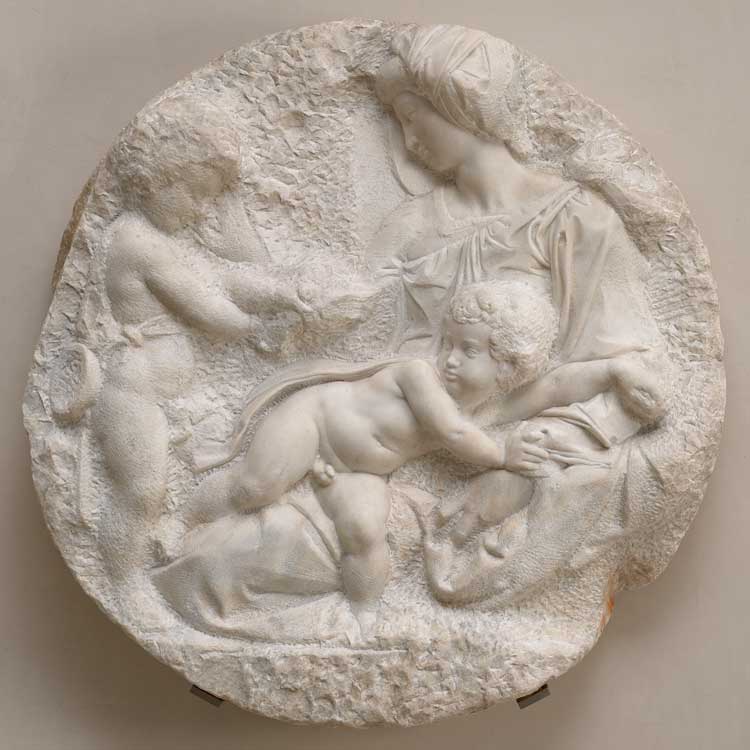
Michelangelo Buonarroti, The Virgin and Child with the Infant Saint John (The Taddei Tondo), c1504-05. Marble, 106.8 x 106.8 cm. Royal Academy of Arts, London. Bequeathed by Sir George Beaumont, 1830. Photo: Royal Academy of Arts, London, Photographer: Prudence Cuming Associates Limited.
Yet the story begins with sculpture. And so it continues, with chapter one focusing on the Royal Academy’s own, much-loved, Taddei Tondo (c1504-05). Michelangelo, despite continuing to paint until his death, really wanted to be a sculptor. In 1503, he had been commissioned by the Arte della Lana (Wool Guild) to make statues of the 12 apostles for the Duomo, at the rate of one a year. He only ever worked on one, of St Matthew, however, and eventually wormed his way out of the agreement. At about the same time, though, he was working on three tondi – one painted and two in relief (only the Taddei Tondo is in the exhibition). The tondo format – basically just a round composition – was popular in Florence by the end of the 15th century, and Michelangelo’s commissions came from prominent patrons. His painted tondo, for Agnolo Doni (c1505-06), shows Mary reaching back to pick up the Christ Child, as he clambers down from his father’s arms. Michelangelo’s two marble tondi, however, depict the Virgin and Child with John the Baptist. Whereas in the Pitti Tondo (c1503-04), the latter figure seems to be very much an afterthought, carved in lightly behind the two main figures, in the Taddei Tondo, Christ’s cousin is more apparent (albeit still much less so than Jesus himself, who is struggling away from St John, while twisting round to look back at him. It should also be noted that this tondo was never completed). An interesting comparison is provided through the loan, from the Musée des Beaux-Arts in Strasbourg, of Piero di Cosimo’s painted tondo, The Virgin and Child with the Infant St John the Baptist (c1490-1500), where both infants have equal prominence, standing in the foreground, tussling. The only known preparatory drawings for the Taddei Tondo are for the figure of the infant John the Baptist, made in pen and ink, capturing a variety of poses (on loan from the British Museum). For each sketch, Michelangelo turned the sheet of paper, so that they do not build up into one great palimpsest of movement, as is the case with Leonardo’s ink-covered pages. It is noteworthy here, too, that Michelangelo is known to have destroyed many of his drawings, in an effort to create the impression that he was a genius who poured his inspiration directly on to the canvas.
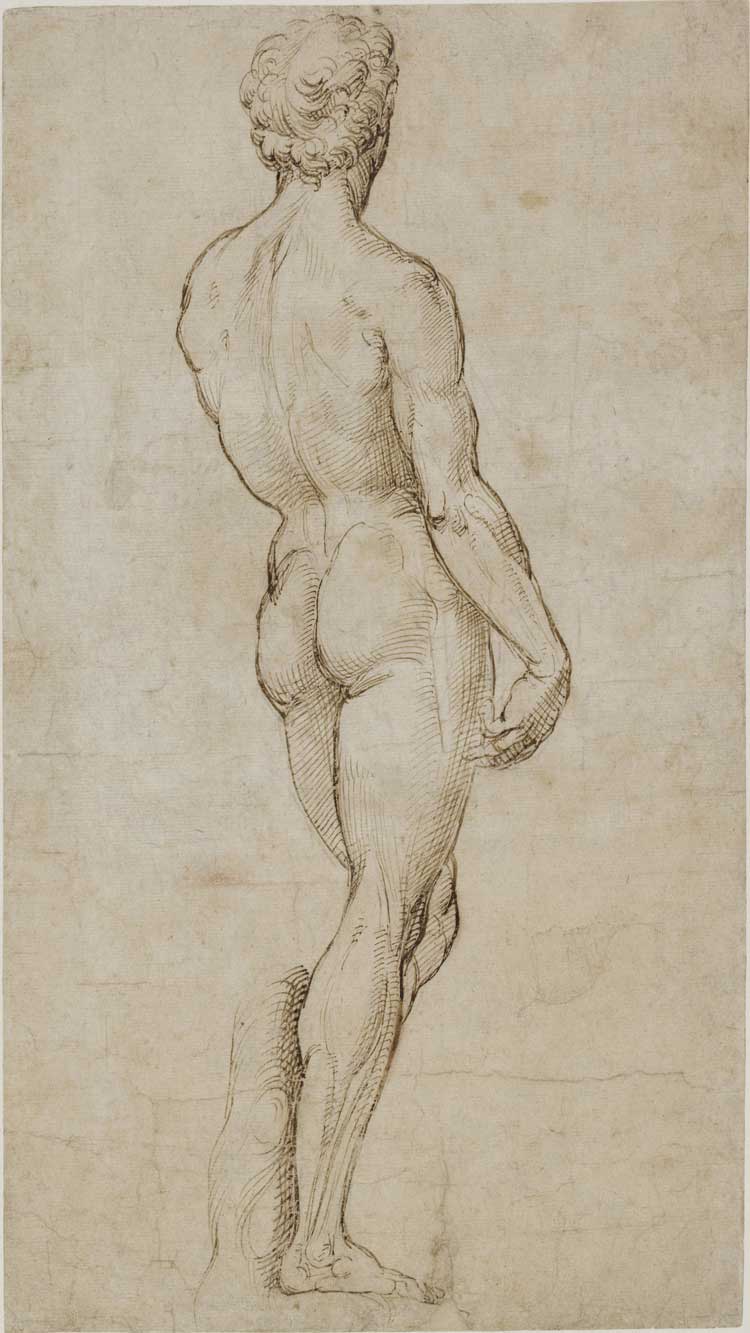
Raphael, after Michelangelo Buonarroti, David, c1505-08. Pen and brown ink on paper, 39.6 x 21.9 cm. © The Trustees of the British Museum.
The drawings by Raphael in this room demonstrate his attempts to absorb the style – and skill – of his two elders. In particular, there is a sketch of Michelangelo’s David (c1505-08), but also a number of studies of the Virgin and Child, some with the infant St John the Baptist, several showing how Raphael sought to interpret – or copy – Michelangelo’s composition of movement and countermovement of the baby, as described above. Compared to Michelangelo and Leonardo, his drawings are minimal – outlines in ink, with a few lines to suggest solidity and shadow, but certainly nothing of the playing with light and muscle, seen in the work of the other two.
Here, chapter two expands from the tondi to focus more broadly on images of the Madonna and Child. Raphael was primarily a painter, and there are two absolutely beautiful works of his on loan: the unfinished Bridgewater Madonna (c1507-08) (from the National Galleries of Scotland), in which the baby Jesus twists à la Taddei Tondo, grasping his mother’s gossamer veil, and The Esterházy Madonna (c1508) (from the Museum of Fine Arts, Budapest), where Mary crouches with her child, forming a pyramidal composition, which directs the viewer’s attention to the scroll held by St John, which, had the picture reached completion, would have borne John’s prophecy on Jesus’s role as redeemer: “Behold, the Lamb of God, who takes away the sin of the world!”2
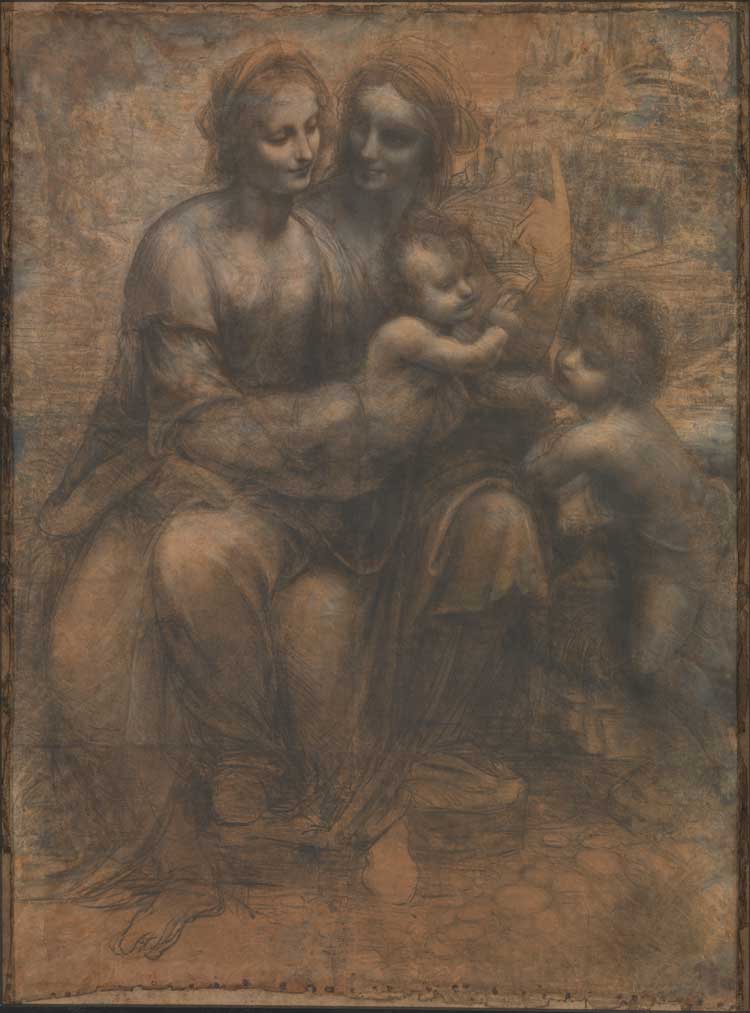
Leonardo da Vinci, The Virgin and Child with St Anne and the Infant St John the Baptist (The Burlington House Cartoon), c1506-08 (detail). Charcoal with white chalk on paper, mounted on canvas, 141.5 x 104.6 cm. The National Gallery, London. Purchased with a special grant and contributions from the Art Fund, The Pilgrim Trust, and through a public appeal organised by the Art Fund, 1962.
Leonardo’s marvellous contribution to this theme is The Virgin and Child with St Anne and the Infant St John the Baptist (“The Burlington House Cartoon”) (c1506-08, although there has been some debate as to the dates of its creation3), which hangs as the star centrepiece in the next room. Originally this work was owned by the Royal Academy (hence its name), but it was sold to the National Gallery in 1962, where it has remained ever since. This is a rare and special loan, the result of a collaboration as part of the National Gallery’s bicentenary celebrations, since the drawing is vulnerable and doesn’t travel well. Well-lit, it hangs here in an otherwise completely darkened space, which is strangely still and meditative (in the centre of a busy gallery in London’s heaving West End), rather like a chapel. The sheer scale of the piece (141.5 x 104.6cm) means it looms tall, in the manner of an altarpiece, but the tenderness of the two women towards one another and the infants spreads a warm glow – perhaps this is the source of the light? Artist and biographer Giorgio Vasari recorded the public response when Leonardo exhibited a cartoon of the Virgin and Child with St Anne: “[M]en and women, young and old, continued for two days to flock for a sight of it to the room where it was, as if to a solemn festival, in order to gaze at the marvels of Leonardo, which caused all those people to be amazed.”4 The supposition that the drawing in question might have been this one is easy to understand.
Two pen-and-ink drawings show Michelangelo also exploring the motif of the Virgin and Child with St Anne, with Mary seated on her mother’s lap. Here, we are given insight into how Michelangelo was influenced and inspired by Leonardo, since this subject matter and composition has no bearing to any commission he is known to have received, but it is, of course, closely related to Leonardo’s cartoon.
With an about turn, the final chapter of the tale moves us on into the realm of battle, focusing on two mural commissions, which bring us back to our starting point. In October 1503, Leonardo had been commissioned by the Republican government to paint a mural, in the Sala del Gran Consiglio, in the newly constructed council hall, in the Palazzo della Signoria, while, in 1504, not long after the installation of his David in front of the building, Michelangelo was commissioned to paint a second mural in the same room. Both murals were intended to depict battles – the Battle of Anghiari (a Florentine victory over Milan in 1440) and the Battle of Cascina (a Florentine victory over Pisa in 1364) respectively – and to glorify the Florentine Republic, now free from the tyranny of the Medicis.
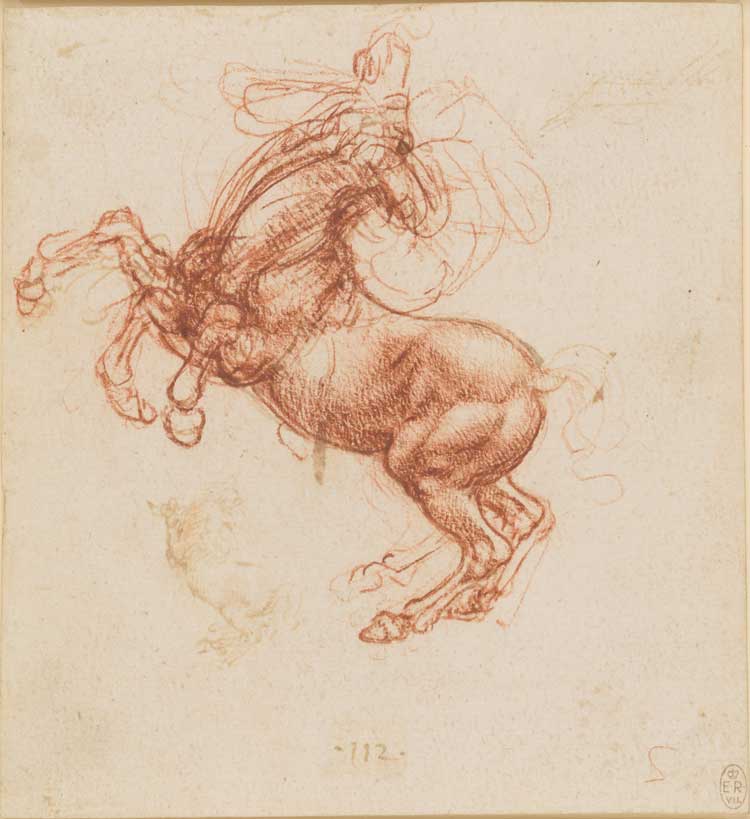
Leonardo da Vinci, A Rearing Horse, c1503-05. Red chalk on paper, 15.3 x 14.2 cm. © Royal Collection Enterprises Limited 2024 | Royal Collection Trust.
In his preparatory drawings, Leonardo focuses on facial expression, capturing the horror and anguish not only of the soldiers, but of their horses alongside them. Wide eyes, wide mouths and a frenzy of pentimenti, creating a sense of hasty movement, fight and flight modes both activated, moments when everything is so overwhelming it all becomes a blur. A Cavalcade (c1503-05), one of a number of drawings on loan from the Royal Collection, is the most wonderful page of black chalk horses, rearing, galloping, lashing from side to side – every bit as full of kinetic energy as Eadweard Muybridge’s photographic studies of motion more than three centuries later. Some sheets mix together studies for different commissions on which Leonardo was working simultaneously – for example, Horse and Rider, and Studies for Leda and the Swan (c1503-05) and Sheet of Various Studies (recto): Horseman Attacking Another, Cogwheels and Lever Action, with Notes (c1503-04), which also features his famous mirror-writing. It comes as little surprise that Leonardo was known for not completing his projects – the Battle of Anghiari included. If these were the study sheets of an artist at work today, there would doubtless be suggestions of ADHD.
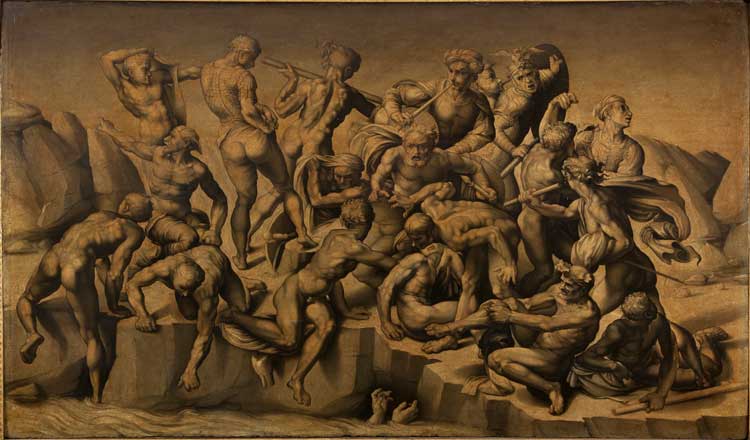
Bastiano da Sangallo, after Michelangelo Buonarroti, The Battle of Cascina (The Bathers), c1542. Oil on panel, 78.8 x 132.3 cm. Holkham Hall, Norfolk, Collection of the Earl of Leicester. By kind permission of the Earl of Leicester and the Trustees of Holkham Estate.
For his “battle scene”, on the other hand, Michelangelo focused on the moment when the soldiers were told of the impending Pisan attack, while bathing in the River Arno. They are depicted as they jump on to its banks and seek to hastily dry and dress themselves. Basically, this was the artist grabbing any opportunity, with any excuse, to study and draw the male nude. Also known as The Bathers, this mural sadly also never came to fruition, and it is represented here by a monochrome oil painting “after Michelangelo” by Bastiano da Sangallo (c1542) (on loan from Holkham Hall, Norfolk). This is accompanied by preparatory anatomical drawings by Michelangelo. And, indeed, his depictions of rippling musculature are unparallelled, drawn in black chalk or pen, and heightened with white to capture the movement of light across the body’s taut surface. One sheet of interest, Head of a Soldier in Profile Wearing a Winged Helmet, and Facial Features (c1504-06) (from the Hamburger Kunsthalle, Kupferstichkabinett) disproves the claim that Michelangelo didn’t concern himself with facial expressions. Here we have two gasping, battle-worn faces, and, even more fascinatingly, and each quite separately, a mouth, a side-on eye, and an exquisitely detailed ear.
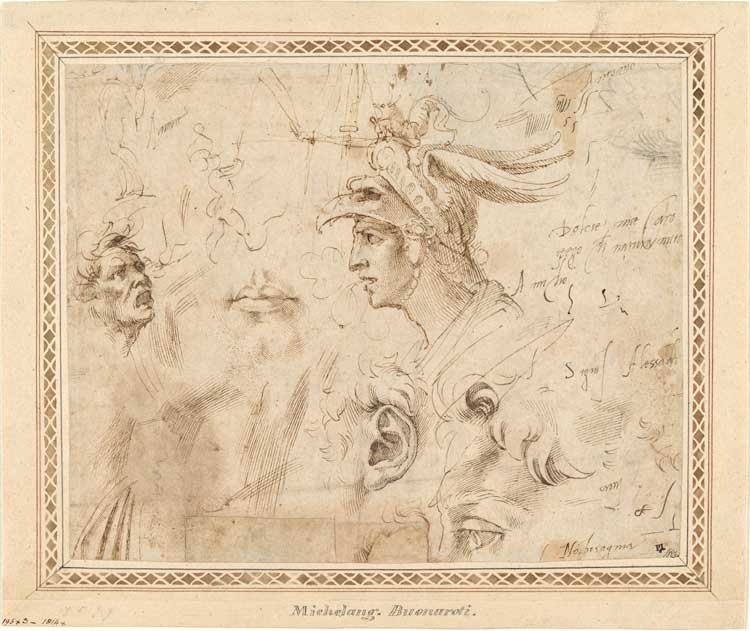
Michelangelo Buonarroti, Studies of Male Heads, Helmets for Soldiers and Facial Features, c1504. Pen and brown ink and black chalk on paper, 20.5 x 25.3 cm. Hamburger Kunsthalle, Kupferstichkabinett. Photo: © Hamburger Kunsthalle / bpk. Photo: Christoph Irrgang.
It is confounding just how fresh these 40-odd fragile works seem – in terms of condition, but also of style. They came into being 520 years ago, but there is the absolute sense that it could have been just yesterday. To return to the point made earlier that this is as much an exhibition about drawing as it is about its three named protagonists, let us only hope that this fundamental and basic art form is one that can be neither ruined nor rendered obsolete in the name of progress, and that, with continued good preservation and collaboration, these works will appear just as fresh and living, and able to relate stories of their creators and subjects, to audiences in another half millennium.
References
1. Florence, c1504: An Introduction by Scott Nethersole and Per Rumberg, in Michelangelo, Leonardo, Raphael: Florence, c1504, Royal Academy of Arts, exhibition catalogue, 2024, pages 11-27, page 27.
2. According to the current information on the painting, written by Axel Vécsey, on the Museum of Fine Arts’ website.
3. Leonardo and the Burlington House Cartoon by Per Rumberg, in exh cat, 2024, pages 45-53, page 49.
4. Lives of the Painters, Sculptors and Architects by Giorgio Vasari, translated by Gaston du C de Vere, edited by David Ekserdjian, Everyman’s Library, 1996, volume 1, page 635, cited in ibid, page 46.